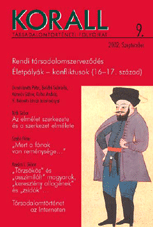Fatányér és kőkorsó. Magyarok és havasalföldiek egy 17. századi
svéd diplomata szemével
Wooden plate and stoneware mug Hungarians and Wallachians – observations of a Swedish diplomat from the 17th century
Author(s): Gábor KármánSubject(s): History
Published by: KORALL Társadalomtörténeti Egyesület
Keywords: social history; cultural relations; 17th century; Hungary; way of life; board; clothing; apodemic literature; travel book
Summary/Abstract: A Swedish diplomat, Claes Rålamb travelled to Constantinople through Hungary, Transsylvania and Wallachia in the years 1657–58 and he described his journey in a diary (preserved in two versions) and several letters. Rålamb’s accounts on his travel are generally considered to be unusually impartial. This seems to be true for his comments on the „Turks”, meanwhile studying his notes about people living on the border of the Ottoman Empire shows that he readily made generalized statements about whole ethnic groups derived from individual cases. The analysis of several cultural categories (eating and drinking, clothing, vehicles and accommodations, natural and cultural sceneries, courtesy and representation) shows that he perceived the people living in this area as backward and sometimes even offensive. Although he came from another European periphery, with his Western-European system of norms he represents the cultural turn which took place in Sweden in the middle of the 17th century and is usually described as an accelerating integration to Europe.
Journal: Korall - Társadalomtörténeti folyóirat
- Issue Year: 2002
- Issue No: 9
- Page Range: 107-136
- Page Count: 30
- Language: Hungarian

